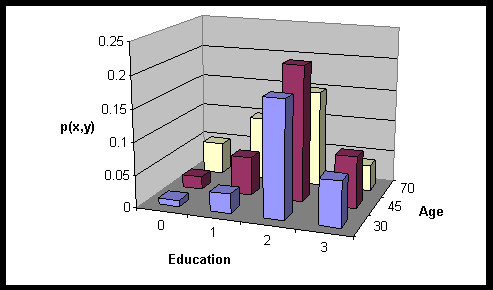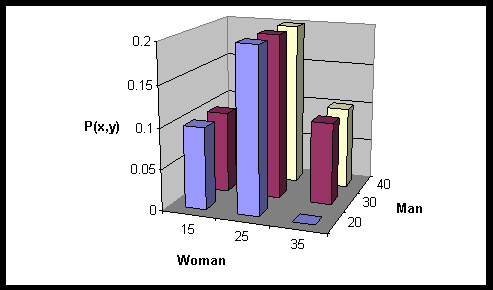Homework #5--Suggested Answers
ISBE 4.22, 4.29, 5.1, 5.9, 5.13, 5.17, 5.26
4.22
- Pr(X>120) = Pr(Z>.5) = 0.309, thus the proportion of
students finishing within 2 hours is 1-Pr(Z>.5) = 0.691,
or 69.1%
- 135.6 minutes. First, find the value of z such that Pr(Z>=z)
= 0.1 by finding 0.1 in Table IV and identifying the associated
z score, z=1.28. Use equation 4-23 to solve for X, which is 135.6.
4.29
Answers A, B, and E are true as they are linear transformations
of the random variable X. In D, 10 does not equal 9. In C, 3.75
does not equal 10/3.
5.1
- 7%
|
|
Age Y |
|
|
X |
30 |
45 |
70 |
|
0 |
0.01 |
0.02 |
0.05 |
|
1 |
0.03 |
0.06 |
0.1 |
|
2 |
0.18 |
0.21 |
0.15 |
|
3 |
0.07 |
0.08 |
0.04 |
b.
|
X |
p(x) |
Y |
p(y) |
|
0 |
0.08 |
30 |
0.29 |
|
1 |
0.19 |
45 |
0.37 |
|
2 |
0.54 |
70 |
0.34 |
|
3 |
0.19 |
|
|
c. No. Pr(X=3,Y=30)=0.07 does not equal Pr(X=3)*Pr(Y=30) = 0.29*0.19=
0.0551, for example.
d. m
X = 1.84 or the sum 0*.08 + 1*.19 + 2*.54 + 3*.19
s
X= .82 or the square root of the sum (0-1.84)2*.08 + (1-1.84)2*.19 + (2-1.84)2*.54 + (3-1.84)2*.19
e. As an example, here is what Excel does. You will have done this by
hand, though, and it will most likely look more like figure 5-2 in the book.

5.9
- 16.17, or the sum .4(1)2*20*.16 + .4(1)2*25*.09 + .4(1.25)2*20*.15 + .4(1.25)2*25*.30 + .4(1.5)2*20*.03 + .4(1.5)2*25*.17 + .4*(1.75)2*20*.0 + .4*(1.75)2*25*.1--formula 5-9
- 6.6, calculation similar to 5.1 d
- 6145, multiply average volume by number of trees (16.17*380)
- E(D) = 1.2875, E(H) = 23.3, No
5.13
- For part c, r
= 0, as s
x,y = 0. Yes, X and Y are independent (compare the joint probabilities
with a table of p(x)p(y); they are the same).
For part d, r
= 0, as s
x,y = 0. No, X and Y are not independent as the joint probabilities
are not the same the values in a table of p(x)*p(y). For example,
0=Pr(x=0,y=2) does not equal Pr(x=0)*Pr(Y=2)=(1/8)*(1/2).
- Statement (1) is true, statement (2) is false.
5.17
a.
|
|
Woman |
|
|
Man |
15 |
25 |
35 |
|
20 |
0.1 |
0.2 |
0 |
|
30 |
0.1 |
0.2 |
0.1 |
|
40 |
0 |
0.2 |
0.1 |

b. For the random variable X: p(X=20) = 0.3, p(X=30)
= 0.4, p(X=40) = 0.3, E(X) = 30, and Var(X) = 60. For the
random variable Y: p(Y=15) = 0.2, p(Y=25) = 0.6, p(Y=35) =
0.2, E(Y) = 25, Var(Y) = 40
s
x,y = 20
E(S) = 55, Var(S) = 140
E(W) = 38, Var(W) = 66.4
E(D) = 5, Var(D) = 60
Not very good. In an observational study like this, confounding
factors (for example, years of education or experience, choice of
vocation, etc.) may cause the difference in income.
5.26
- Negative. When S is large, T tends to be small; when S is small,
T tends to be large. Start by transforming percents to decimals; on
this scale, the covariance = - 0.0008.
- When investing all in stocks return, R = 10,000*S; investing all
in t-bills R = 10,000*T; investing 50-50, R = 5,000*S + 5,000*T and
investing 20-80 R = 2,000*S + 8,000*T. Note that E(S) = 0.09, E(T)
= 0.08, SD(S) = 0.0943 and SD(T) = 0.0127. Use the formulae in Table
5-7, line 2 (page 175 of the book) to fill in the table:
|
Stock/Treasury Bills Split |
Expected Value |
Standard Deviation |
|
100/0 |
900 |
943 |
|
0/100 |
800 |
127 |
|
50/50 |
850 |
432 |
|
20/80 |
820 |
142 |
- 100% investment in Stocks gives the highest return, whereas the lowest
risk is associated with 100% in T-bills.
- No, expected return is highest with all resources devoted to the
instrument (stocks) of highest return.
- Yes. Note that E(R) = 10,000*(a*E(S) + (1-a)*E(T)), that is,
expected return is a linear combination of return on stocks and return
on T-bills. The constant "a," which ranges from 0 to 1, determines
the fraction invested in stocks. This expression can be re-written
E(R) = 10,000*(a*(E(S)-E(T)) + E(T)). Filling in the values for
E(T) and E(S), we get E(R) = 100*a + 800, the equation of a line
with positive slope. E(R) is maximized by choosing as large a value
for "a" as we can, i.e. a=1, corresponding to all money in stocks.
- Yes, risk is typically lower with a mix of two negatively correlated
investments (when one goes down, the other tends to go up, compensating
losses). Risk should be smallest with somewhere between 0 and 20% in
stocks.
- The ratio is (var(T) - cov(S,T))/(var(S) - cov(S,T)) = 10. Hence
a ratio of 10-1 investment in favor of T-bills (1/11 in stocks, 10/11
in T-bills) has lowest risk (SD(R) = 86).
- was not; all in stocks ; 1/11th in stocks; careful evaluation of.


